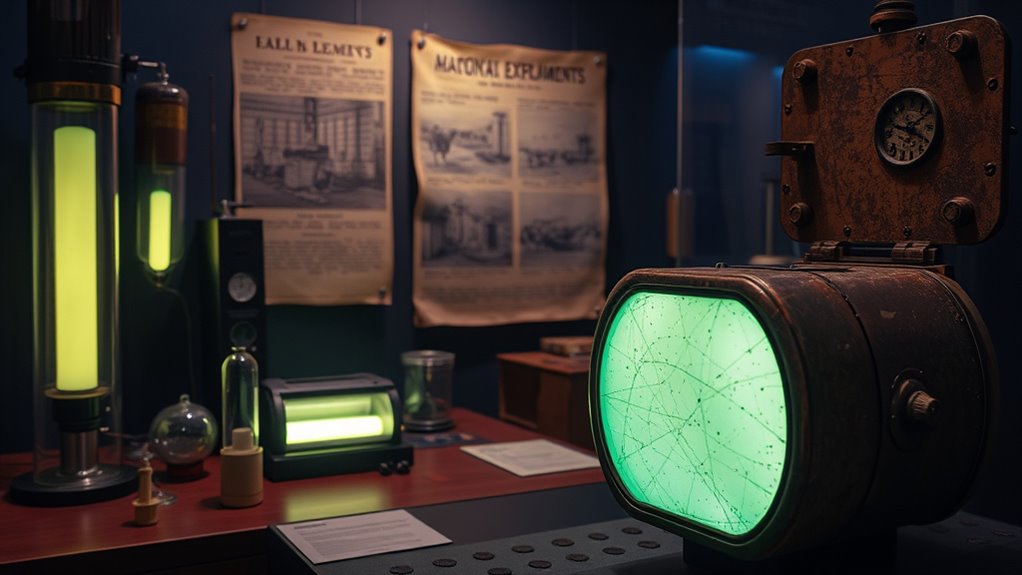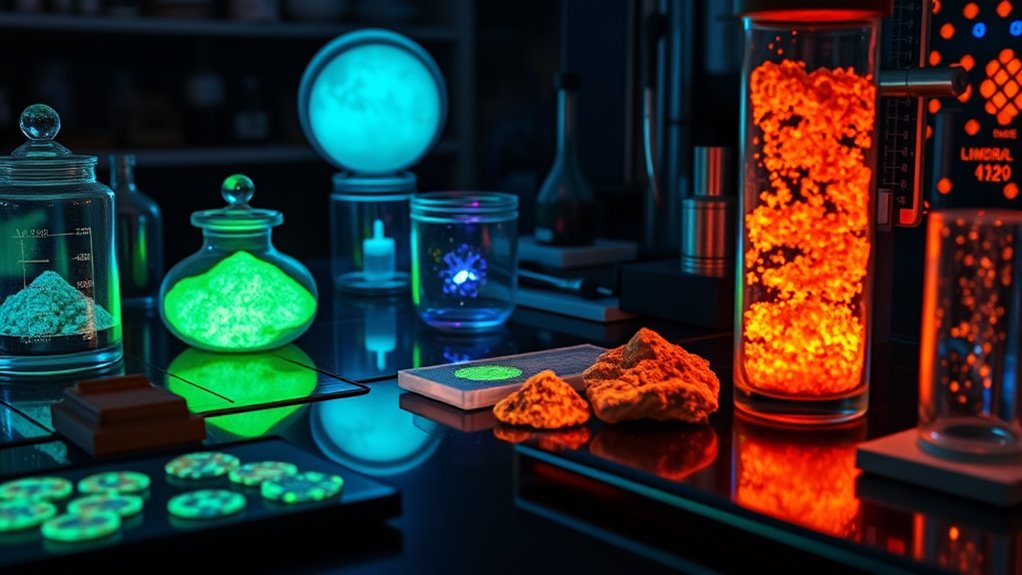Throughout history, humans have used natural phosphors like calcite and zinc sulfide in paints, jewelry, and artifacts that glow in the dark. These materials absorbed light during the day and emitted it slowly at night, adding mystique and beauty to various objects. Over time, scientific advancements led to synthetic phosphors with tailored properties, powering modern glow-in-the-dark signs, safety equipment, and displays. If you’re curious, there’s much more to discover about how these luminous materials evolved and transformed across ages.
Key Takeaways
- Ancient civilizations used mineral-based phosphorescent materials like calcite and zinc sulfide for decorative and religious objects.
- Scientific advancements led to the development of synthetic phosphors with tailored luminescent properties.
- Modern photoluminescent materials include rare-earth-doped compounds used in safety signs, watches, and medical imaging.
- Continuous research aims to improve efficiency, brightness, and color range of phosphors with nanomaterials and new compounds.
- The evolution from natural minerals to engineered phosphors reflects a blend of historical fascination and scientific innovation.

Photoluminescent materials have fascinated humanity for centuries, illuminating our world in ways that blend science and art. From the earliest times, people have harnessed the glow of phosphorescent substances to serve practical and decorative purposes. Ancient uses of luminescent materials include the application of mineral-based paints and stones that glowed in the dark, such as the use of certain phosphorescent minerals in jewelry and pottery. These materials, often naturally occurring phosphors like calcite or zinc sulfide, were valued for their ability to absorb light during the day and emit it slowly at night, creating a mysterious glow that added a touch of magic to everyday life. Cultures across the globe, from ancient Egypt to China, employed these luminous materials in amulets, religious artifacts, and decorative objects, underscoring their cultural significance and the human desire to manipulate light. Over time, scientists discovered ways to enhance these materials, leading to the development of synthetic phosphors with tailored properties for specific applications. As centuries passed, scientific understanding of these phenomena advanced, paving the way for modern innovations in photoluminescent materials. Today, you benefit from a sophisticated array of phosphors engineered for specific purposes, such as safety signs, watch dials, and emergency lighting. Modern innovations have focused on enhancing the efficiency, brightness, and longevity of these materials. Unlike their ancient counterparts, which relied on naturally occurring minerals, contemporary phosphors are often synthesized in labs, allowing for precise control over their properties. For example, advances in chemistry have led to the development of rare-earth-doped phosphors, which emit brighter and longer-lasting light than traditional minerals. These innovations have expanded the applications of photoluminescent materials far beyond their ancient uses, making them integral to safety systems, medical imaging, and even entertainment technology. You now witness the culmination of centuries of exploration and experimentation in the glowing materials around you. Modern photoluminescent technologies continue to evolve, driven by ongoing research into new compounds and nanomaterials that can emit light more efficiently and in a broader range of colors. The journey from ancient mineral-based luminescence to high-tech, custom-designed phosphors illustrates a fascinating interplay of science, creativity, and utility. Understanding phosphors and their properties helps us appreciate how these materials continue to brighten our world in innovative ways. Whether in decorative objects, safety devices, or cutting-edge displays, the legacy of ancient uses merges seamlessly with modern innovations, illuminating our world in ever more dazzling and functional ways.
Frequently Asked Questions
How Do Phosphors Convert Energy Into Visible Light?
When you shine energy onto a phosphor, it transfers energy to the material through energy transfer. This causes electrons within the phosphor to become excited, jumping to higher energy levels. As these excited electrons return to their original state, they release the excess energy as visible light. This process of electron excitation and subsequent light emission is how phosphors convert absorbed energy into visible light efficiently.
What Are the Modern Applications of Photoluminescent Materials?
You’ll find photoluminescent materials in modern applications like glow-in-the-dark textiles, enhancing fashion and safety. Emergency signage also relies on these materials to glow in low light, guiding people during power outages or evacuations. These materials absorb light energy and emit it slowly, providing visibility when needed. Their versatility makes them essential in safety, fashion, and even entertainment, ensuring you stay visible and safe in various situations.
How Do Different Types of Phosphors Vary in Efficiency?
You might worry that all phosphors are equally efficient, but their luminescence efficiency varies greatly due to differences in phosphor composition. Some materials, like zinc sulfide, offer high efficiency and bright glow, while others, like calcium sulfide, are less effective. These variations impact applications from display screens to emergency signage, so choosing the right phosphor depends on understanding how their composition influences their luminescent performance.
What Role Did Ancient Civilizations Play in Phosphor Discovery?
You discover that ancient civilizations played a key role in phosphor discovery through ancient artifacts and early chemical experiments. They noticed glowing materials in artifacts, like jade and minerals, which sparked curiosity. These early experiments with natural substances helped lay the groundwork for understanding luminescence. Their observations and use of glowing minerals contributed to the foundation of phosphor research, influencing later scientific advances in photoluminescent materials.
Are There Environmental Concerns Related to Phosphor Production?
You should be aware that phosphor production has environmental impacts, including toxic waste and resource depletion. To reduce these issues, industries are adopting sustainable practices, such as recycling materials and using eco-friendly chemicals. While these efforts help lessen environmental impact, ongoing research aims to develop greener production methods. Being mindful of these concerns encourages responsible use and supports advancements that benefit both industry and the environment.
Conclusion
Just like a lighthouse guiding ships through darkness, phosphors and photoluminescent materials have illuminated human history. From ancient pigments to modern lighting, they’ve transformed how we see and interact with the world. Their journey is a demonstration of our curiosity and ingenuity, shining brightly through the ages. As you reflect on their evolution, remember that these glowing materials are like silent storytellers, forever lighting the way for innovation and discovery.









